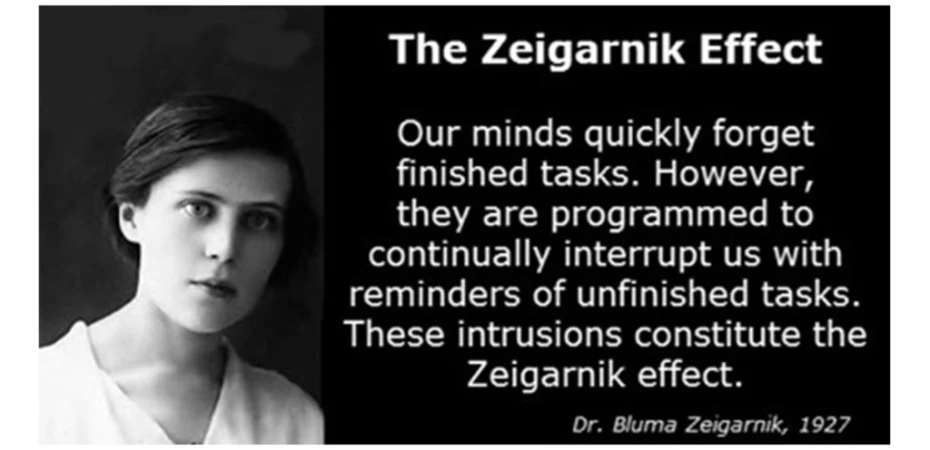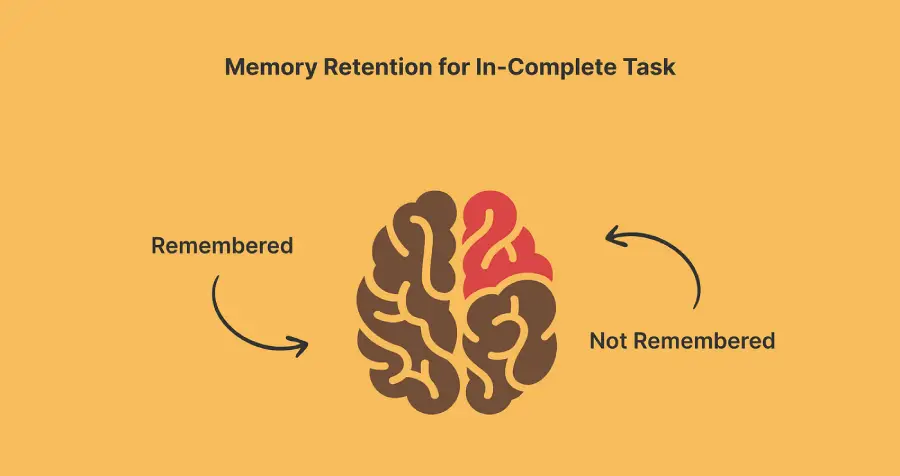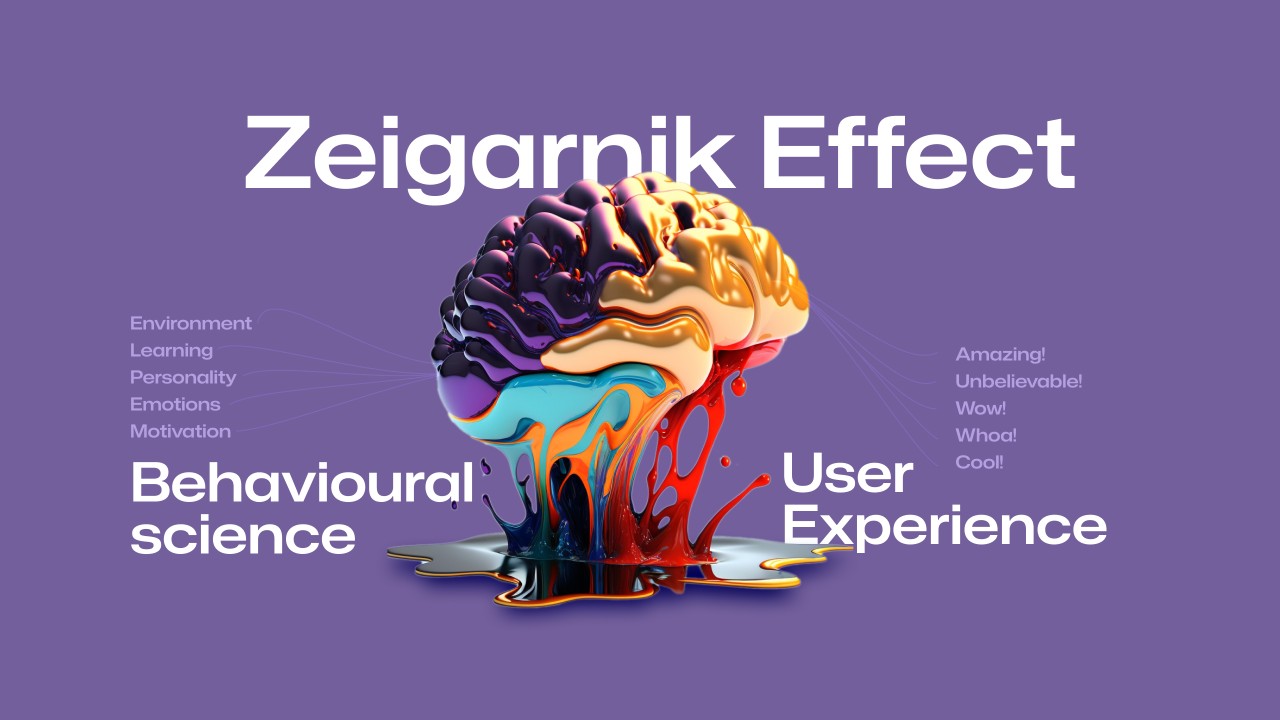You know that feeling when you’re bingeing your favorite show, and the episode ends with a massive friggin’ cliffhanger?
Your mind goes into straight-up meltdown mode, desperate to know what happens next.
You literally can’t think about anything else until you get that sweet, sweet resolution.
That nagging, insatiable curiosity gnawing at your brain?
That’s the Zeigarnik Effect working its voodoo magic.
Named after the Soviet psychologist Bluma Zeigarnik, this psychological principle basically states that our minds tend to remember interrupted or unfinished tasks wayyyyyyy better than completed ones.

🤔 Why Does It Work?
When we encounter an unfinished task, our brain creates this lingering cognitive tension and unresolved feeling that our minds just can’t shake.
Our brains actively maintain laser-focus on that open loop until we can finally close it.
It’s like a mental itch that needs scratching.
There are a few key reasons our brains get so bent outta shape over incomplete tasks:
- A Need for Cognitive Closure – Our minds are straight-up obsessed with resolving ambiguities over sustaining uncertainties. Incomplete tasks are like open dilemmas that defy our innate need for clarity and solid conclusions. Sh*t just doesn’t feel right until we tie up those loose ends.
- Prospective Memory Demands – Unfinished tasks act like nagging reminders that our brains have to maintain and recall until we eventually complete them actively. Dealing with that constant prospective memory load is straight-up taxing on our poor overworked noggins.
- A Drive for Competence – Leaving tasks unfinished can make us feel like failures or weaklings on some primal level. Our deep-rooted desire to be competent hustlers pretty much demands resolving those incomplete suckers.
So, in essence, the psychological itch from unfinished tasks taps into core cognitive tendencies around craving closure, managing our mental load, and proving our self-worth. Resolving that tension by wrapping up tasks satisfies those deeply ingrained neural drives in a way that’s just intrinsically rewarding for our brains.
🌇 How big companies are using the Zeigarnik Effect

Duolingo’s Streaky Genius
Raise your hand if you’ve felt straight-up victimized by Duolingo’s judgemental owl when you miss a language lesson. *raises hand in utter shame*
That’s because the smart cookies at Duolingo tapped into the Zeigarnik Effect by introducing streaks – a visual rep of your continuous progress.
Mess up that streak, and bam!
You’ve got a glaring case of unfinished business staring you down every time you open the app.
The only way to resolve that nagging tension?
Keep grinding away at those lessons, turning you into a habitual user. Pshht, genius.
Hotmail’s Cliffhanger Masterclass
Back in the wild west days of the 90s internet, Hotmail had a serious challenge – convincing people to actually, ya know, use their fresh new email service.
Their diabolical solution?
Some classic Zeigarnik tension, of course.
See, when you received an email on Hotmail, the subject line would roll up like “Subject: Part1” or “Subject: Part2” and so on.
It drove people legitimately crazy not knowing if they were missing crucial context from earlier parts of the convo.
With that nagging incompleteness eating away at them, they’d have no choice but to open those emails and get that sweet, sweet resolution to the cliffhanger.
Diabolical mind games.
Ahrefs’ Unfinished Feature Teasers
For new tool releases, Ahrefs teases by showing previews with key capabilities omitted, like their “Content Explorer” lacking info on filters and integrations.
This incompleteness leaves questions that drive desires to experience the full, resolved tool version at launch.
Creating that tension of unfinished business compels customers to engage with Ahrefs to finally get the complete picture.
🎯 How to Use Status Quo Bias in Your Marketing
Now, if you want to implement the Zeigarnik Effect with your own SaaS offer and turn your customers into straight-up fan addicts, here’s how:
1) Run free trial periods, but lock out certain key features to leave an unfinished product experience.
2) Add progress bars, level systems, or streaks to your product so users get visual cues of tasks left unfinished.
3) For content like blogs, vids, or emails, stop giving away the full enchilada upfront. Drip that valuable shit out bit by bit to leave ’em craving more.
4) When dropping new features or updates, tease that fresh hotness gradually before the full unveil to really build up the anticipation.
5) Write content with killer cliffhangers at the end to leave your audience straight-up jonesing for the rest of that story’s resolution.
6) Create saucy email sequences that trickle out info and offers over time instead of dumping it all at once.
But don’t go too far with those unfinished teases, player.
If you leave customers with perpetual unfinished business and never provide that satisfying payoff, you’ll just end up with a buncha frustrated, raging psychos.
With great power comes great responsibility and all that, ya dig?


Leave a Reply